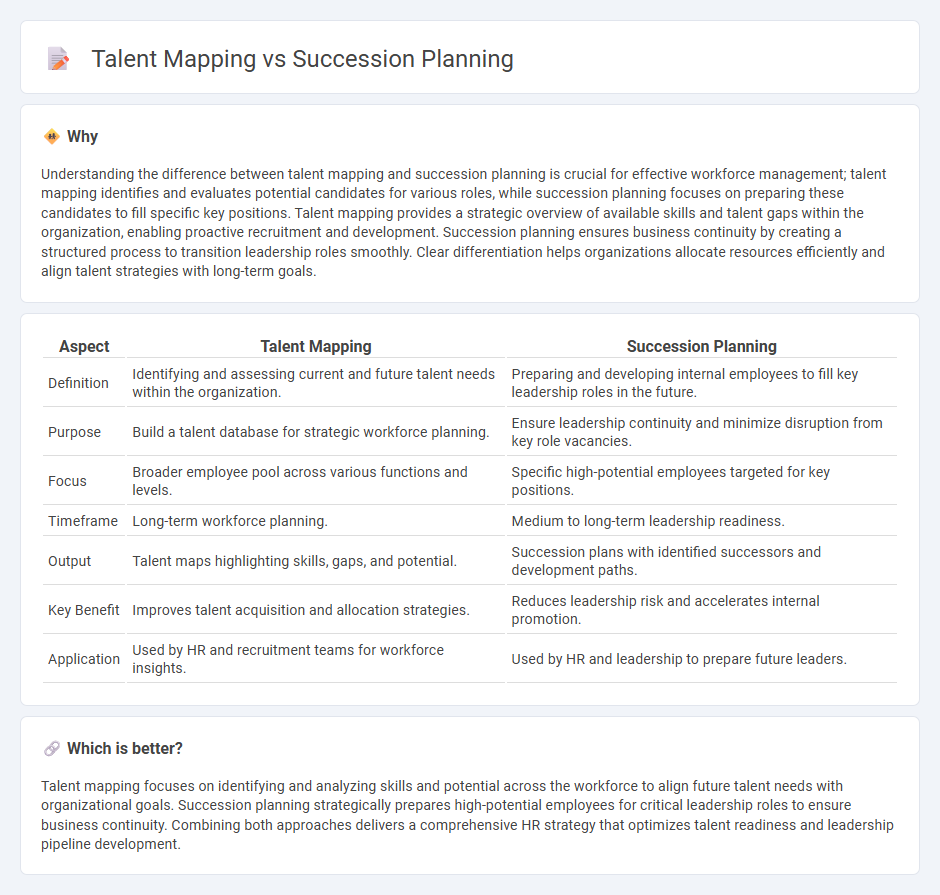
Talent mapping identifies current employee skills and potential to align workforce capabilities with strategic goals. Succession planning focuses on preparing internal candidates for key leadership roles to ensure business continuity and minimize disruption. Explore how integrating talent mapping with succession planning strengthens organizational resilience.
Why it is important
Understanding the difference between talent mapping and succession planning is crucial for effective workforce management; talent mapping identifies and evaluates potential candidates for various roles, while succession planning focuses on preparing these candidates to fill specific key positions. Talent mapping provides a strategic overview of available skills and talent gaps within the organization, enabling proactive recruitment and development. Succession planning ensures business continuity by creating a structured process to transition leadership roles smoothly. Clear differentiation helps organizations allocate resources efficiently and align talent strategies with long-term goals.
Comparison Table
| Aspect | Talent Mapping | Succession Planning |
|---|---|---|
| Definition | Identifying and assessing current and future talent needs within the organization. | Preparing and developing internal employees to fill key leadership roles in the future. |
| Purpose | Build a talent database for strategic workforce planning. | Ensure leadership continuity and minimize disruption from key role vacancies. |
| Focus | Broader employee pool across various functions and levels. | Specific high-potential employees targeted for key positions. |
| Timeframe | Long-term workforce planning. | Medium to long-term leadership readiness. |
| Output | Talent maps highlighting skills, gaps, and potential. | Succession plans with identified successors and development paths. |
| Key Benefit | Improves talent acquisition and allocation strategies. | Reduces leadership risk and accelerates internal promotion. |
| Application | Used by HR and recruitment teams for workforce insights. | Used by HR and leadership to prepare future leaders. |
Which is better?
Talent mapping focuses on identifying and analyzing skills and potential across the workforce to align future talent needs with organizational goals. Succession planning strategically prepares high-potential employees for critical leadership roles to ensure business continuity. Combining both approaches delivers a comprehensive HR strategy that optimizes talent readiness and leadership pipeline development.
Connection
Talent mapping identifies high-potential employees by analyzing skills, performance, and career aspirations to align them with organizational needs. Succession planning uses talent mapping insights to strategically prepare these employees for future leadership roles, ensuring business continuity. Together, they create a proactive approach to workforce development and leadership stability.
Key Terms
Succession planning:
Succession planning strategically identifies and develops internal candidates to ensure seamless leadership transitions and organizational continuity. It involves assessing key roles, evaluating potential successors' skills, and creating tailored development plans to prepare talent for future responsibilities. Explore comprehensive strategies to enhance your succession planning and secure leadership stability.
Leadership Pipeline
Succession planning identifies and develops future leaders to ensure a seamless transition in key leadership roles, emphasizing long-term organizational stability. Talent mapping assesses current skills and potential across the workforce, creating a strategic overview to fill leadership gaps proactively. Discover detailed strategies to build a robust leadership pipeline through effective succession planning and talent mapping.
Critical Roles
Succession planning ensures leadership continuity by identifying and developing internal candidates for critical roles, while talent mapping provides a comprehensive overview of potential talent across the organization, highlighting skill gaps and future needs. Focusing on critical roles in both processes prioritizes organizational stability and operational excellence by aligning talent strategies with business goals. Discover how mastering these strategies can secure your company's competitive advantage and future growth.
Source and External Links
Succession Planning: All You Need To Know [2025 Edition] - AIHR - Succession planning is the process of selecting and developing key talent to ensure continuity in critical roles, involving steps like identifying key positions, assessing current talent, and creating a development roadmap.
Succession Planning: 7-Step Guide & Template - Paylocity - Succession planning is a proactive, long-term strategy to identify and train employees who can fill key roles, ensuring business continuity and smooth leadership transitions.
Succession planning - Wikipedia - Succession planning is a strategy to identify and develop potential leaders to fill critical roles when they become vacant, applicable across businesses, family firms, and even political systems to ensure stability and prevent power struggles.
 dowidth.com
dowidth.com